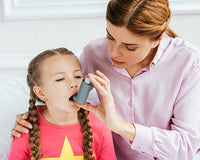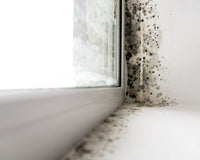We often think of dirty air in terms of busy roads and exhaust fumes but some of the most immediate dangers are found within our four walls. Here we explain how many of them are caused by cleaning products, candles, carpets and even paint and then kept inside your home by modern sealed windows.
Air pollution is usually presumed to be an outdoor problem caused by traffic and industry. But the pollution inside our homes and work places can be just as harmful.
Even before the pandemic, it was estimated we spent 85-90% of our time inside - where air pollution is caused by factors including heating, cooking, ventilation, damp, building materials, vehicle exhaust fumes from the road, and biological factors such as dust mites and fungi. A 2019 study by environmental charity Global Action Plan found levels of ultra-fine particles indoors on average three and a half times higher inside than those outside. According to the Royal College of Physicians, nearly 100,000 deaths in Europe each year can be attributed to indoor air pollution.
A 2019 study by environmental charity Global Action Plan found levels of ultra-fine particles indoors on average three and a half times higher inside than those outside. According to the Royal College of Physicians, nearly 100,000 deaths in Europe each year can be attributed to indoor air pollution.
“Given how much time is spent indoors, when we’re looking at the health effects of the air we breathe, the indoor space has got to be an important part of the conversation,” says Steven Holgate, Medical Research Council clinical professor of immunopharmacology at the University of Southampton.
But if that’s enough to make you want to scrub your place from top to bottom, you might want to reconsider reaching for the kitchen spray.

“There are a lot of the chemicals in cleaning products and we keep introducing more and more chemicals into our homes,” notes Holgate. “There are studies into how the mix of these chemicals can impact male fertility and female cancers. A lot of this starts when a baby is born and they are crawling around on the floor breathing in all these chemicals used for cleaning.” “We know so little about the chemicals in the indoor air that we are breathing all the time and we need to really start concentrating on that,” says Prof Holgate, who chaired a ground-breaking report into the effects of indoor air pollution by the Royal College of Paediatrics and Child Health and the Royal College of Physicians.
“We know so little about the chemicals in the indoor air that we are breathing all the time and we need to really start concentrating on that,” says Prof Holgate, who chaired a ground-breaking report into the effects of indoor air pollution by the Royal College of Paediatrics and Child Health and the Royal College of Physicians.
“It’s been neglected and the regulation concerning indoor environments is very weak. And yet, in the long term, it’s going to have bad effects on us.”
Catherine Sutton, a mother of two from Lewisham, knows the effect poor indoor air quality can have. Her son Edward was five when his chronic cough was linked to airborne allergens, particularly dust mites.
At home, Sutton bought anti-dust mite covers and a high efficiency particulate air (TRUE HEPA) filter. The more precautions she took, the better Edward was. There are growing concerns for the impact indoor air pollution can have on our health - even those who don’t have an immediate and obvious reaction.
There are growing concerns for the impact indoor air pollution can have on our health - even those who don’t have an immediate and obvious reaction.
We need to consider the long-term implications, argues Jonathan Grigg, professor of paediatric respiratory and environmental medicine at Queen Mary University of London, and co-author of the royal colleges’ report.
“It’s somewhat different from outdoor air pollution because you’re getting long-term exposures to a wide range of different chemicals over long periods of time, as opposed to the short-term exposure of walking for five minutes on a very busy road.”
And it isn't just cleaning products that are responsible for poor indoor air quality. There are many different kinds of pollution inside our homes, from particulate matter - microscopic particles of dust and dirt in the air - to gases such as carbon monoxide, nitrogen oxides or sulphur dioxide.
The push for more energy-efficient homes - better for the environment and residents’ bank balances - has also had a negative impact on indoor air quality. As buildings become more airtight and have less ventilation, pollutants have nowhere to go.
Airborne chemicals, for example, are found in everyday products and materials including mattresses, household cleaners, candles, carpets, furniture and paint. In enclosed spaces, like our homes or offices, these emitted gases accumulate and can pollute our air.
Airborne chemicals can cause short-term problems like headaches, inflammation of the eyes, nose and throat, and flare-ups of chest infections, as well as contributing to the development of more long-term conditions like asthma. Another common air pollutant is mould. Exposure to mould spores can have direct adverse effects on our health, ranging from common irritations and allergic reactions to asthma attacks or an increased risk of long-term lung damage.
Another common air pollutant is mould. Exposure to mould spores can have direct adverse effects on our health, ranging from common irritations and allergic reactions to asthma attacks or an increased risk of long-term lung damage.
According to a study by doctors from the University of Manchester, there is a strong connection between mould exposure in infants and the development of asthma by age three. Only maternal smoking has a stronger link with asthma. Over time, pollution can have more serious implications including the onset of cardiovascular and respiratory conditions and other known health risks.
These include impaired cognition, gene changes which can cause cancer, and other serious health problems such as chronic obstructive pulmonary disease, stroke, type II diabetes, Parkinson’s and Alzheimer’s disease.
Children are most at risk, according to a report by the Royal College of Paediatrics and Child Health and the Royal College of Physicians. The report says: “From conception through to early adulthood, organs such as the lung and brain continue to grow and develop. This makes children and young people particularly vulnerable to the effects of indoor and outdoor air pollution. “It remains of utmost importance for children’s health to reduce the exposure to and the adverse effects of outdoor air pollution, but little attention has been given to pollutant exposures indoors.”
“It remains of utmost importance for children’s health to reduce the exposure to and the adverse effects of outdoor air pollution, but little attention has been given to pollutant exposures indoors.”
If you are concerned about the quality of air, that you, your children and loved ones are breathing in your home, please take a look at the Winix Zero air purifier with TRUE HEPA filter and clean the air you breathe from viruses, bacteria, allergens, dust, pollen, pet dander, cigarette smoke, mould spores, odours and other harmful particulate matter.













